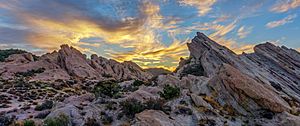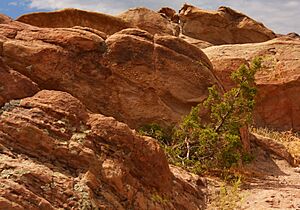Vasquez Formation facts for kids
Quick facts for kids Vasquez FormationStratigraphic range: Late Oligocene-Early Miocene (Arikareean) ~25–20.4Ma |
|
|---|---|

The Vasquez Formation at Vasquez Rocks Natural Area
|
|
| Type | Formation |
| Sub-units | Subdivision |
| Underlies | Paradise Springs Formation & Tick Canyon strata |
| Overlies | San Francisquito Formation, Triassic Mount Lowe intrusive suite & Jurassic syenite (basement) |
| Thickness | 3,810 m (12,500 ft) |
| Lithology | |
| Primary | Conglomerate, sandstone |
| Other | Basalt, andesite, rhyodacite, rhyolite, trachyandesite, limestone |
| Location | |
| Coordinates | 34°28′48″N 118°19′00″W / 34.48000°N 118.31667°W |
| Region | Los Angeles County, California |
| Country | |
| Extent | Vasquez Rocks Natural Area, Sierra Pelona Ridge, San Gabriel Mountains Punchbowl Block & Soledad Basin |
| Type section | |
| Named for | Tiburcio Vasquez |
| Named by | Sharp |
| Year defined | 1935 |
The Vasquez Formation (Tvz) is a special type of rock layer. You can see it at the famous Vasquez Rocks in southern California. These rocks formed a long, long time ago, between about 25 and 20.4 million years ago. This time period is known as the Late Oligocene to Early Miocene epochs.
Contents
What is the Vasquez Formation?
The Vasquez Formation was first studied in 1935. It is found in the Los Angeles Basin area. These rocks were laid down in small basins, which are like dips in the land. These basins were located between two big faults: the San Gabriel Fault and the San Andreas Fault.
The Vasquez Formation sits on top of much older rocks. These older rocks are called the "basement" and formed during the Triassic and Jurassic periods. The Vasquez Formation is covered by other rock layers, like the Paradise Springs Formation and the Tick Canyon Formation.
What the Rocks Look Like
The Vasquez Formation is mostly made of yellowish and reddish sandstone and conglomerate. Conglomerate is a rock made of many different sized pebbles and rocks cemented together. It also contains volcanic rocks like andesite and basalt. The whole formation can be as thick as 3,810 meters (about 12,500 feet)!
Many parts of the formation include large chunks of rock called "megabreccia." These are often made of just one type of rock. This formation is the lowest layer of rocks that were not formed in the ocean.
The rocks are often bright red. The conglomerate rocks have pebbles that are not very round and are mixed together unevenly. This suggests they were carried by fast-moving flows of mud and rocks.
How the Rocks Formed
The Vasquez Formation is believed to have formed from alluvial fans. These are fan-shaped deposits of sand, gravel, and mud that form where a fast-moving river or stream slows down and spreads out.
Some parts of the Vasquez Formation also show signs of huge rock avalanches. There are also thin layers of limestone mixed in. Limestone often forms in lakes, so this suggests there were small lakes that formed when volcanic lava flows blocked rivers.
Volcanic rocks found in the formation help scientists figure out its age. For example, some volcanic rocks called rhyolite have been dated to about 24.4 million years old. This helps us know when the Vasquez Formation started to form.
When the Rocks Were Deposited
Around 21 million years ago, during the Early Miocene, the land in this area looked different. There was a high area to the southeast. Alluvial fans spread out from this high area towards the northwest, depositing the rocks we now see as the Vasquez Formation.
These rocks were laid down before the San Gabriel Fault became very active. Even though no fossils have been found in the Vasquez Formation yet, scientists believe there's a good chance they might be discovered in the future!
Parts of the Vasquez Formation
Scientists have divided the Vasquez Formation into four main types based on the kinds of rocks found in each part. This is called their "lithology" (the study of rock types).
- Tvza - Andesitic Volcanic Rocks: These are dark gray to reddish-brown volcanic rocks. They are very hard and have tiny crystals inside. You might see patterns in them from when the lava flowed.
- Tvzb - Basaltic Volcanic Rocks: These are dark gray volcanic rocks, similar to basalt. They also have small crystals. These rocks are very strong and resist weathering.
- Tvzc - Non-Marine Conglomerate: This part is made of pebbles and cobbles (larger, rounded stones) mixed with red clay. These rocks were carried by rivers. They contain rounded pieces of gray, tan, pink, and lavender volcanic rocks, as well as granite-like rocks.
- Tvzs - Sedimentary Rocks: This unit is also made of pebbles and cobbles from rivers, mixed with red clay. Like the conglomerate, it has rounded pieces of volcanic and granite-like rocks.
Images for kids




